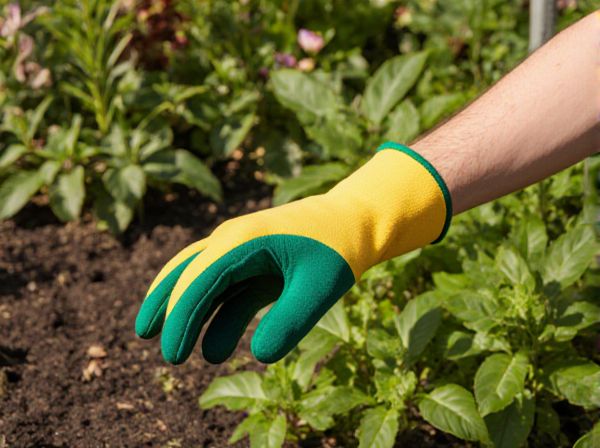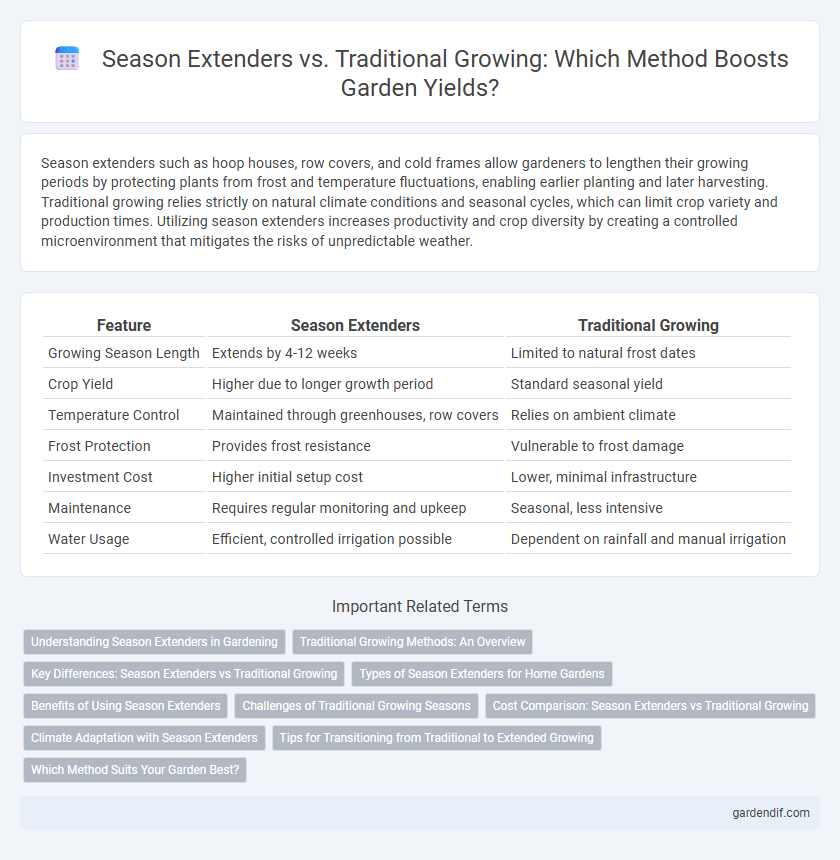
Season extenders vs Traditional growing Illustration
Season extenders such as hoop houses, row covers, and cold frames allow gardeners to lengthen their growing periods by protecting plants from frost and temperature fluctuations, enabling earlier planting and later harvesting. Traditional growing relies strictly on natural climate conditions and seasonal cycles, which can limit crop variety and production times. Utilizing season extenders increases productivity and crop diversity by creating a controlled microenvironment that mitigates the risks of unpredictable weather.
Table of Comparison
| Feature | Season Extenders | Traditional Growing |
|---|---|---|
| Growing Season Length | Extends by 4-12 weeks | Limited to natural frost dates |
| Crop Yield | Higher due to longer growth period | Standard seasonal yield |
| Temperature Control | Maintained through greenhouses, row covers | Relies on ambient climate |
| Frost Protection | Provides frost resistance | Vulnerable to frost damage |
| Investment Cost | Higher initial setup cost | Lower, minimal infrastructure |
| Maintenance | Requires regular monitoring and upkeep | Seasonal, less intensive |
| Water Usage | Efficient, controlled irrigation possible | Dependent on rainfall and manual irrigation |
Understanding Season Extenders in Gardening
Season extenders like row covers, cold frames, and high tunnels enable gardeners to protect plants from frost and extend the growing period beyond traditional seasonal limits. These tools moderate temperature extremes and reduce wind exposure, promoting healthier plant development and increased yields. Compared to conventional gardening methods, season extenders optimize growing conditions and allow for earlier planting and later harvesting, enhancing overall productivity.
Traditional Growing Methods: An Overview
Traditional growing methods rely on natural climatic conditions to dictate planting and harvesting cycles, often limiting crop production to specific seasons. These techniques include soil preparation, crop rotation, and the use of native plant varieties adapted to local environments. While traditional methods promote sustainability and biodiversity, they may result in lower yields compared to season extenders that modify environmental factors.
Key Differences: Season Extenders vs Traditional Growing
Season extenders utilize tools such as row covers, high tunnels, and cold frames to lengthen the growing period by protecting crops from frost and extreme temperatures, unlike traditional growing which relies solely on natural weather conditions. These methods enable earlier planting and later harvesting, enhancing yield and crop diversity by creating microclimates that stabilize temperature and humidity. Traditional growing typically limits planting to the defined local growing season, resulting in a shorter harvest window and higher vulnerability to weather fluctuations.
Types of Season Extenders for Home Gardens
Season extenders for home gardens include row covers, cold frames, and hoop houses, each designed to protect plants from frost and extend the growing season. Row covers made from lightweight fabric trap heat and shield crops from wind, while cold frames use transparent panels to harness sunlight and maintain warmth. Hoop houses, constructed with plastic sheeting over curved frames, create a mini-greenhouse environment, making them effective for prolonging growth in early spring and late fall.
Benefits of Using Season Extenders
Season extenders, such as row covers, hoop houses, and cold frames, significantly prolong the growing period compared to traditional methods by protecting plants from frost and temperature fluctuations. These tools enhance crop yield and quality by maintaining optimal microclimates, reducing plant stress, and enabling earlier planting and later harvesting. Utilizing season extenders also conserves energy and reduces the need for chemical treatments, promoting sustainable agricultural practices.
Challenges of Traditional Growing Seasons
Traditional growing seasons face limitations such as susceptibility to unpredictable weather patterns, shorter growing periods, and higher risks of pest infestations. These constraints often result in reduced crop yields and restricted harvest windows, impacting overall agricultural productivity. In contrast, season extenders mitigate these challenges by creating controlled environments that allow for longer and more consistent growing periods.
Cost Comparison: Season Extenders vs Traditional Growing
Season extenders such as high tunnels and row covers typically involve higher initial setup costs compared to traditional growing methods, but they reduce long-term expenses by extending the growing season and increasing crop yields. Traditional growing relies heavily on natural weather conditions, leading to shorter harvest periods and potentially higher losses due to frost or temperature fluctuations. Over time, season extenders offer cost efficiency by minimizing the need for replanting and enabling earlier market access, which can result in greater overall profitability.
Climate Adaptation with Season Extenders
Season extenders, such as high tunnels, row covers, and greenhouses, significantly enhance climate adaptation by creating controlled microclimates that protect crops from frost, extreme temperatures, and unpredictable weather patterns. Unlike traditional growing methods, season extenders extend the growing period, allowing for earlier planting and later harvesting, which increases yield and reduces crop stress from climate variability. These technologies optimize temperature, humidity, and soil conditions, enabling growers to adapt to shifting seasons and improve food security amid changing climate conditions.
Tips for Transitioning from Traditional to Extended Growing
Maximize productivity when transitioning from traditional growing to season extenders by gradually introducing protective covers such as row covers or high tunnels to safeguard crops from frost and temperature fluctuations. Monitor soil moisture closely and adjust irrigation practices to prevent overwatering under extended seasons, as sheltered environments often reduce evaporation rates. Implement crop rotation and integrated pest management to maintain soil health and reduce pest pressures intensified by prolonged growing periods.
Which Method Suits Your Garden Best?
Season extenders like row covers, cold frames, and hoop houses provide effective microclimate control to prolong the growing period beyond traditional planting schedules. Traditional growing relies on natural seasonal cycles, which limits harvest times but requires less initial investment and equipment. Evaluating your garden's space, climate challenges, and crop types helps determine whether season extenders or traditional methods will maximize yield and adaptability.
Season extenders vs Traditional growing Infographic

 gardendif.com
gardendif.com